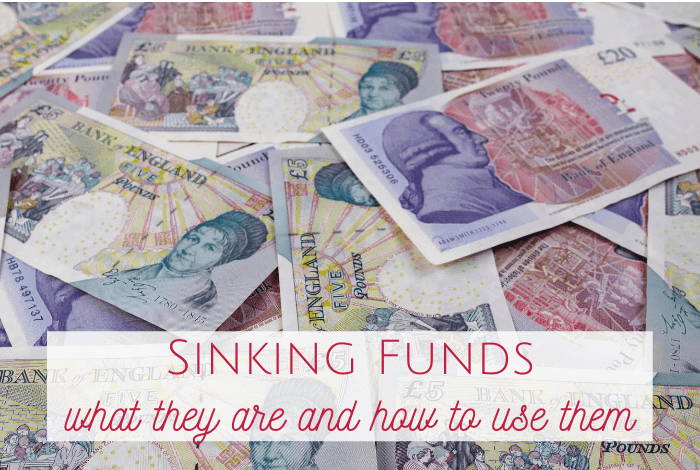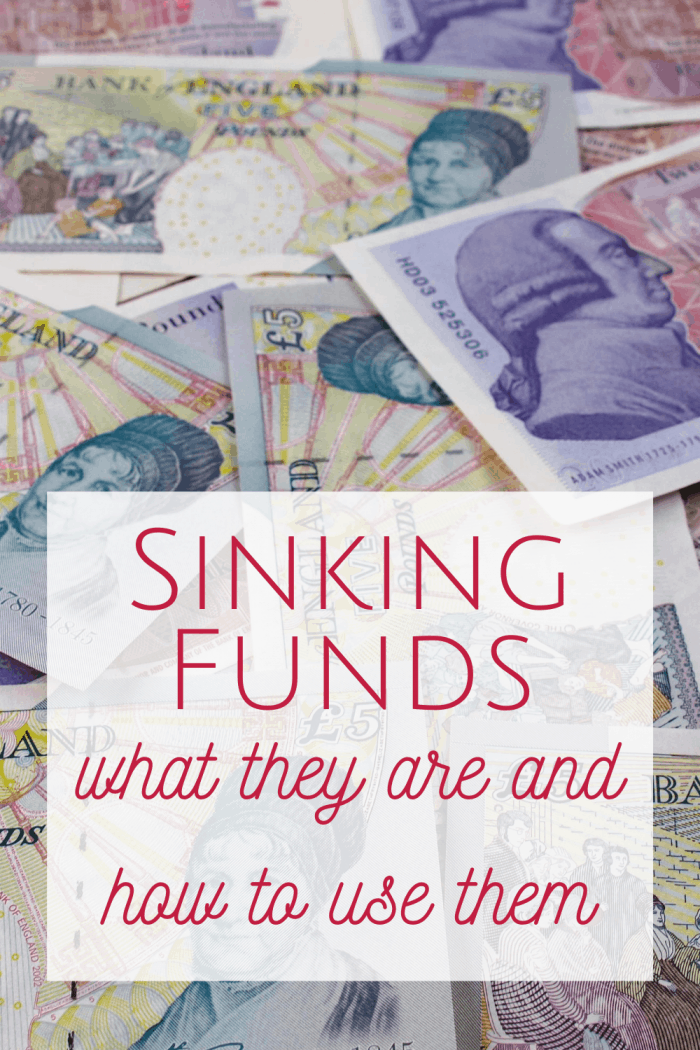Last week, I asked if you were financially resilient and one of the things I mentioned was using sinking funds to save for some of your expenses which is something that I don’t currently do. I wanted to tell you a bit more about them though so I asked the very lovely Steph from Debt Free Family to pop over and tell you how she uses sinking funds.

Hello! I’m Steph and I blog over at Debt free family (https://debtfreefamily.co.uk) where I write about family finances, earning a bit more and spending a bit less!
I’m going to write today about sinking funds, what they are, the best way to set them up and how to use them.
One in 8 UK adults has no cash savings and a whopping 32% of the British population has less than £2,000 saved for emergencies and the younger you are, the less you’re likely to have saved up.
So why is this? It’s blamed on a number of factors, but it’s hard to pinpoint the exact reason as we’re all different. Some economists believe the high cost of living in many parts of the UK and low wages are to blame, but not knowing how to save is likely to be a huge factor as well.
What is a sinking fund?
If you’ve never heard of a sinking fund, you’re not alone. What is it? It’s simply a fancy economic term for saving up for something. It could be anything. If you’ve ever saved up for something specific, you’ve created a sinking fund.
If you’re wondering what the difference is between sinking funds and the saving accounts we all know about already, then the answer is ‘not a lot’, except for one difference and it’s this difference that makes saving in sinking funds far easier, and makes you more likely to succeed than a traditional savings account.
With a regular savings account, you save up however much you can afford each month, let’s say £200 and then at the end of the year you’ve got £2,400. That £2,400 you’ve saved up might be for car repairs, a holiday, re-doing the kitchen or any number of things. There’s one pot of money at the end of the year and you decide how to spend it.
In a sinking fund, you still save £200 each month but you split it between any number of ‘pots’ depending on what you’re saving for. So for example, you might be saving for car repairs, your holiday and redoing your kitchen but you’d intentionally split your money each month into separate pots, which might look like this:
- Car repairs £75 per month (£900 annually)
- Holiday £100 per month (1,200 annually)
- Kitchen decoration per month £25 (£300 annually)
The main advantage of sinking funds over regular savings accounts is that you know how much you’ve budgeted for each specific goal and how much you need to put away each month to achieve it. It makes saving for a bigger purchase easier by breaking it down into monthly payments. Think of it as the reverse of financing a new car, for example. Instead of making a payment each month to the garage you bought your car from, you’re making that payment into your ‘car’ sinking fund, which you can then use to go and buy your car with cash!
Sinking funds don’t only have to be for purchases though. Any payment you know is coming up can be saved for in a sinking fund, as can house deposits, weddings, tax expenses etc… but one thing to bear in mind is that sinking finds are not emergency funds. I’ll explain the difference between them further on.
Can’t I save in a regular account?
Saving in a traditional account will give you the same total at the end of the year you’ll have if you create your sinking funds.
The major benefit of sinking funds isn’t that you’re magically able to save more money, the magic is in the shift in mindset having sinking funds gives you.
Traditional savings accounts can leave you in a dilemma come to the end of the year.
You want a new car, but also to get your kitchen done but then you see a nicer car and the money’s there so you use more even though you wanted to get the kitchen done and now you can’t…..you get the idea.
Having one sinking fund for one goal makes saving easier. You see your goal getting nearer and nearer every month and it feels good. It motivates you, so you keep saving. It’s a simple strategy, but it’s an effective one.
Sinking funds vs emergency funds
Sinking funds are not emergency funds. Why? Because sinking funds are for expenses that you can predict, budget for and then save for.
Emergency funds are for just that, emergencies! A new car, getting married or redoing your kitchen are not emergencies, they’re intentional choices we make. We then decide how much we’d like to spend, how much we can afford and then save accordingly.
Your emergency fund is for the things that happen in life that we simply can’t foresee. What sort of things might these be? A small curveball like a burst water pipe, right through to being made redundant from your job are all real emergencies.
Not sure if it’s an emergency? Ask yourself if you could have saved for the specific issue a year beforehand. If the answers No, then it’s an emergency. If the answers Yes, then you need to use a sinking fund, not your emergency fund.
How many sinking funds can I create?
As many as you want! There is no limit to the amount of sinking funds you can have, and you can make them over whatever time frame you like. In our house, we have 7 sinking funds going on right now. Four of them are over 12 months, as they’re yearly expenses, and the other three are over two years.
When I talk to people about sinking funds, I’m often asked what they are. So, we have:
Over 12 months
- Christmas (we have this every single year, starts in Jan, guess when it ends! :))
- Holiday
- Driving lessons (One of our kids will turn 17 and start to drive)
- Tax payments
Over 24 months
- Conservatory repairs (they’re in no way urgent, they’ll just need doing at some point. So they’ve gone into a slower sinking fund)
- New car (We change our car every two years if we can, for a ‘new to us’ car)
- New drive (This is a want, and a bit of a luxury so again, it’s a slower sinking fund and we’ll get the new drive when we’ve saved up)
So you see, you can create a sinking fund for anything!
Where should you store your sinking fund money
Personally, we use Starling bank as we already had an account with them and when we started to use sinking funds, they have something called ‘spaces’ (which are essentially pots you can separate money into and label them with individual names) and were perfect for sinking funds.
You can create as many spaces as you like and not only name them but give a savings target amount as well.
Then every time you move money into one of your sinking funds, it tells you as a percentage how near you are to your goal.
I really like being able to visually see all my sinking funds in one place, and see them grow every month.
Many people, however, use spreadsheets to do the same thing and this works just as well. The trick is to be able to ‘see’ the money grow bigger and nearer to your savings goal. That’s where the motivation is.
I hope this has made sinking funds a little clearer for you. I can tell you, for me, they turned saving into something I actually look forward to every month, knowing the things I’m planning are getting a bit nearer. I hope they help you too!
i style=”font-weight: bold;”>Don’t miss out on future posts like this – receive updates directly to your inbox by email by adding your email address here and hitting subscribe. You can also follow me on Twitter or BlogLovin and I’d love to see you over on my Facebook page and on Instagram. If you’re interested, you can find out more about me here. 😉
Why not Pin ‘Sinking Funds – what they are and how to use them’ for later?










